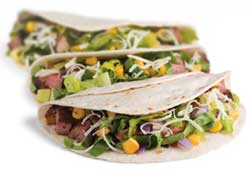The saying “what is old is new again” rings especially true in the restaurant industry. As is the case with most trends, contemporary restaurant concepts are usually recycled ideas that are given new life. With that said, new concepts aren’t really new at all, just some rehashed version of something that was already tried in the last millennium. Here are a few restaurant concepts billed as “contemporary” that actually have been around for a while.
1) Recycled Tex-Mex
 |
Tex-Mex cuisine had its heyday during the late ’80s. This fusion of American and Mexican cuisines was pervasive back in the day, ranging from fast-food concepts to finer Southwestern fare put out by chefs like Mark Miller of Coyote Café fame. During the ’90s, this movement gave way to Neuvo Latino fare, which was an amalgamation of European and Latin culinary concepts. The popularity of Tex-Mex and Neuvo Latino concepts (in their original forms) started to fade in the new millennium — morphing into an-anything-goes-as-long-as-it-sells mentality. In essence, you don’t see as many upscale Latin fusion concepts anymore, just a profusion of fast-casual “Mexican Grill” concepts that crowd America’s suburban boulevards. At these places, the same fusion of American and Latin concepts, especially Mexican, gets employed–only the format has changed. Many of these Mexican grill restaurants like to think they are doing things differently than the competition, yet the menus are basically the same. Dishes like fish tacos with mango salsa and poblano pesto burritos are hardly new concepts. But don’t tell that to corporate places like Qdoba Grill and Chipotle because they think they are onto something new.
2) Super-Asian Cuisine
Pan-Asian fare was extremely popular during the early ’90s, and it still is in many regions of the country, even though the cuisine gets recycled and constantly reinvented. This style of food draws influences from all over Asia–from Korea to Vietnam to China to Japan, and so on. Celebrity chef Wolfgang Puck helped to define this fusion cuisine in the U.S with his Chinois and Obachine restaurants, giving it a distinctive modern touch. But it’s kind of a stretch to say that Pan-Asian cuisine is a hot, new cuisine, as some chain restaurants are currently boasting. Maybe it’s a new concept in Omaha or Topeka, cities that tend to be about 10 years behind the times, in terms of the restaurant industry, but it mostly came and went in cities like Seattle and Los Angeles. So, in reality, large chain restaurants such as P.F. Chang’s and Zyng Asian Grill are really dishing up has-been food from the last century — a good thing if it’s done right, which is not often the case.
3) Is That A Sword With Meat On It?
 |
Just when you think a cuisine is dead and gone, someone attempts to revive it, as is the case with rodizio-style steakhouse concepts. These Brazilian steakhouses enjoyed a good run in most large American cities during the ’90s. But recently they started popping up again in smaller cities that apparently missed them the first time around. These kinds of restaurants are all about spectacle, with waiters, called “gauchos” decked out in traditional Brazilian garb. These fanciful waiters carry around large skewers (think swords) pierced with assorted rotisserie-cooked meats, offering them to frightened-looking customers. Most rodizio-style restaurants have a color-coded system so the servers know when customers want more meat, or when the customers are about to explode and they need to stop pushing the proteins: sirloin steak, beef tenderloin, bacon-wrapped turkey, Brazilian-style sausage (linguica), ham, etc… Since Americans tend to be gluttons, Brazilian steakhouses are popular with the all-you-can-eat crowd. Go ahead. Eat till you drop. That’s a modern thing to do.
4) That’s One Swanky Steakhouse
 |
Glitzy steakhouses were all the rage during the ’50s and ’60s. Crooner music wafted through the swanky dining rooms, as big steaks and baked potatoes were plunked down in front of smiling diners. Those were good times. Of course, you would have started with a shrimp cocktail and crab bisque before embarking on that 16-ounce porterhouse, finishing off with a flaming cherries jubilee. Sounds like fun. During the ’80s and early ’90s, upscale steakhouse concepts still existed but the serious swank all but disappeared. Eventually, some restaurateurs realized the fun was gone and resurrected the swanky steakhouse. (El Gaucho in Seattle and Mastro’s Steakhouse in Scottsdale, Ariz., are good examples.) A la carte menus, which are common at swanky steakhouses, have always been expensive in relation to the era, yet the current high price tags on menu items can cause some major sticker-shock. You do the math: $38 for a pan-seared ribeye steak. $5 for a baked potato. $6 for sautéed mushrooms. $5 for grilled asparagus. Yikes! Talk about maxing out the credit card.
5) What Do You Mean They Grew The Food Nearby?
 |
Farm-to-table restaurants have become in vogue lately, yet this fresh-as-it-gets concept is hardly a new thing. Famous localphile Alice Waters has served farm-fresh fare at Chez Panisse (in Berkeley, Calif.) for nearly four decades. And most restaurants in the early to middle of the 20th century served lots of local food–grown and raised within a close proximity to the restaurant–not because it was cool, but because there used to be a lot more family-run farms across the U.S. The recent artisan farming revolution, helped greatly by a bustling, nationwide farmers market scene, has enabled smaller family-operated farms once again to thrive. These new farmers have created tight bonds with chefs and restaurateurs who desire to serve impeccably fresh food. Some farm-to-table restaurants take it literally by growing and raising the food right on the premises. (The Herbfarm near Seattle has had great success doing this concept.) Now, that’s commitment.
We always want to be transparent and honest about our article content. From time to time, we may link to products and services that compensate us for the referral. This does not affect your cost, but it does help us fund future content for this site.
